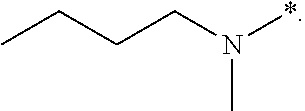1,4-benzodiazepinone compounds and their use in treating cancer
a technology of 1,4-benzodiazepine and compounds, applied in the field of1,4-benzodiazepine compounds, can solve the problems of insufficient treatment of agents such as these, insufficient treatment of cancer patients, and insufficient treatment of current therapies, many of which involve a combination of chemotherapy or surgery and radiation
- Summary
- Abstract
- Description
- Claims
- Application Information
AI Technical Summary
Benefits of technology
Problems solved by technology
Method used
Image
Examples
example 1
Representative Procedure for Synthesis of Benzo[e][1,4]diazepin-2(3H)-ones from Imidoyl Chlorides
Part I: Palladium-Coupling of a Heteroaryl Boronic Acid and an Imidoyl Chloride
[0186]
5-(5-Aminopyridin-3-yl)-7-chloro-3-(2-chlorobenzyl)-1-(4-methoxybenzyl)-1H-benzo[e][1,4]diazepin-2(3H)-one
[0187]5,7-Dichloro-3-(2-chlorobenzyl)-1-(4-methoxybenzyl)-1H-benzo[e][1,4]diazepin-2(3H)-one (240 mg) and 5-(4,4,5,5-tetramethyl-1,3,2-dioxaborolan-2-yl)pyridin-3-amine (134 mg, 1.2 eq) were suspended in dioxane / water (6 mL / 2 mL), and then cesium hydroxide (170 mg, 2 eq) was added and the mixture was degassed by pulling vacuum until bubbling occurred, and then introducing nitrogen gas. The degassing procedure was repeated twice, and then tetrakis(triphenylphosphine)palladium(0) (30 mg, 0.05 eq) was added. The degassing procedure was repeated once, and then the reaction was heated to 90° C. for three hours. The crude mixture was then diluted with EtOAc (20 mL) and then washed with water, then brine, a...
example 2
Representative Procedures for the Synthesis of a 1,4-Benzodiazepinone bearing a C5-1H-Imidazo[4,5-b]pyridin-2(3H)-one Group
Part I: Synthesis of Imidazo[4,5-b]pyridin-2(3H)-one Boronic Acid
Step 1
[0213]
5-Bromopyridine-2,3-diamine
[0214]5-Bromo-3-nitropyridin-2-amine (3 g) was dissolved in isopropyl alcohol (56 mL) and water (28 mL). Ammonium chloride (1.47 g, 2 eq) was added followed by iron powder (2.31 g, 3 eq). The reaction was heated to 90° C. for 45 minutes. The solution was then cooled, and diluted with EtOAc, filtered, and the layers were separated. The organic layer was then washed with brine, dried over sodium sulfate, and concentrated delivering product as a solid (2.45 g, 95% yield). 1H-NMR (300 MHz, DMSO-d6) δ 7.25 (d, 1H), 6.77 (d, 1H), 5.70-5.40 (bs, 2H), 5.20-4.80 (bs, 2H).
Step 2
[0215]
6-Bromo-1H-imidazo[4,5-b]pyridin-2(3H)-one
[0216]5-Bromopyridine-2,3-diamine (2.45 g) was dissolved in THF (25 mL) and 1,1′-carbonyldiimidazole (2.54 g, 1.2 eq) was added. The reaction was s...
example 3
Procedures for the Synthesis of a 1,4-Benzodiazepinone bearing a C5-Pyridin-2-yl)piperazine Group
Part I: Synthesis of 6-(4-Methylpiperazin-1-yl)pyridinyl Boronic Acid
Step 1
[0227]
1-(5-Bromopyridin-2-yl)-4-methylpiperazine
[0228]5-Bromo-2-chloropyridine (1.0 g), N-methylpiperazine (1.56 g, 3 eq), and potassium carbonate (2.16 g, 3 eq) were combined in N-methylpyrrolidinone (5 mL) and heated to 120° C. overnight. The crude mixture was then cooled to room temperature and diluted with water. The solid product was collected by filtration, then washed with more water and dried under vacuum (824 mg, 62% yield). 1H-NMR (300 MHz, CDCl3) δ 8.18 (d, 1H), 7.50 (dd, 1H), 6.53 (d, 1H), 3.50 (m, 4H), 2.50 (m, 4H), 2.33 (s, 3H).
Step 2
[0229]
1-Methyl-4-(5-(4,4,5,5-tetramethyl-1,3,2-dioxaborolan-2-yl)pyridin-2-yl)piperazine
[0230]The reaction was carried out as described in the borylation reaction in Part I of Example 2 to provide the title compound (132 mg, 14% yield). MS (ES+) m / z 304.2 (M+1).
Part II: ...
PUM
| Property | Measurement | Unit |
|---|---|---|
| temperature | aaaaa | aaaaa |
| time | aaaaa | aaaaa |
| temperature | aaaaa | aaaaa |
Abstract
Description
Claims
Application Information
 Login to View More
Login to View More - R&D
- Intellectual Property
- Life Sciences
- Materials
- Tech Scout
- Unparalleled Data Quality
- Higher Quality Content
- 60% Fewer Hallucinations
Browse by: Latest US Patents, China's latest patents, Technical Efficacy Thesaurus, Application Domain, Technology Topic, Popular Technical Reports.
© 2025 PatSnap. All rights reserved.Legal|Privacy policy|Modern Slavery Act Transparency Statement|Sitemap|About US| Contact US: help@patsnap.com



